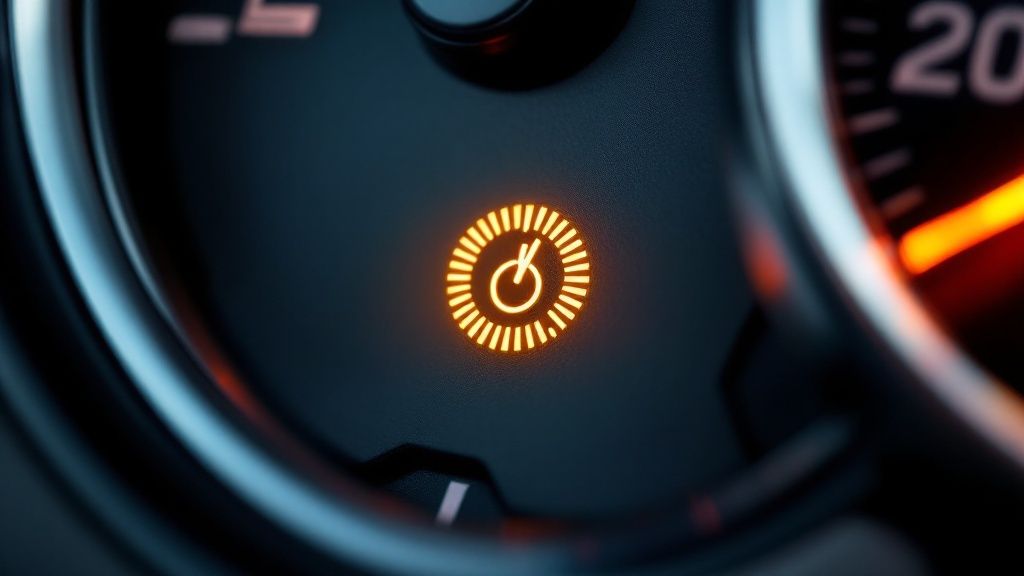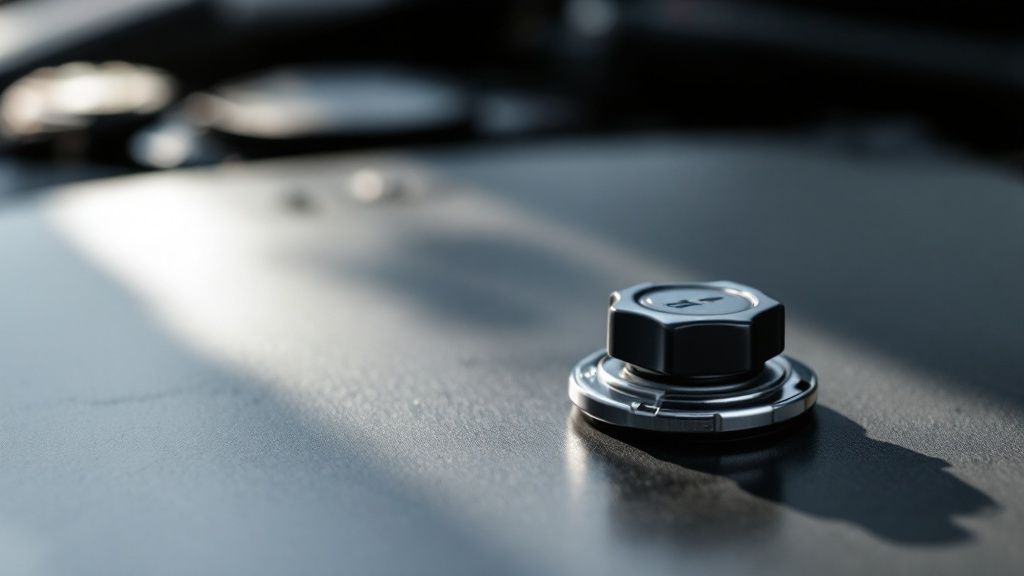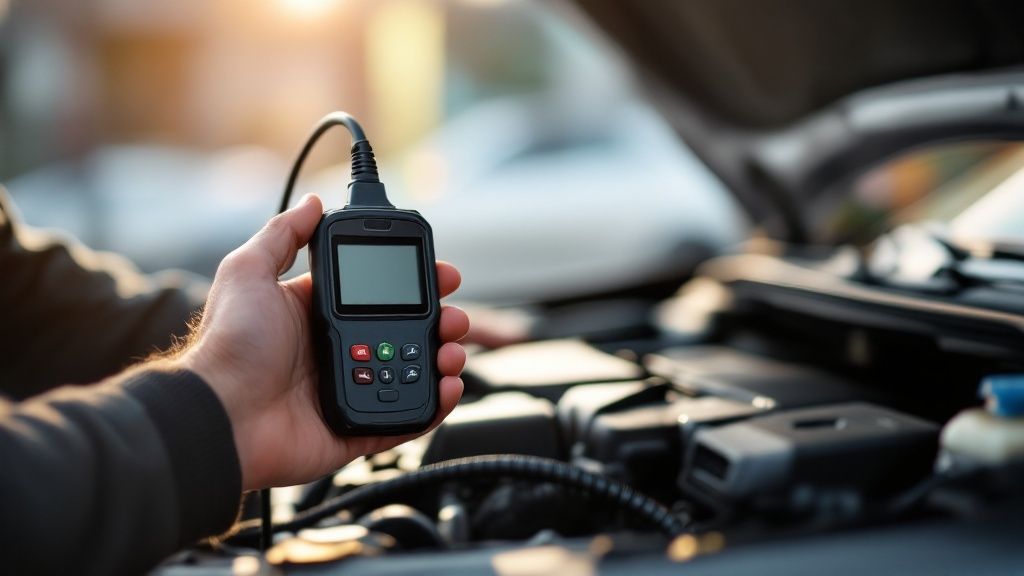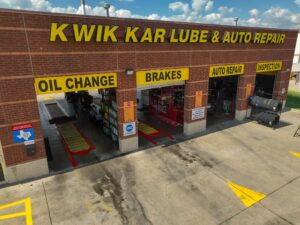Decoding Your Service Engine Light: Beyond the Dashboard Glow
That amber glow on your dashboard – the service engine light – can be unsettling. But understanding its meaning can save you stress and potentially a lot of money. This section demystifies the service engine light, exploring its various patterns and the systems behind this seemingly simple indicator.
Steady vs. Flashing: Understanding the Urgency
The service engine light communicates through different patterns. A steady light often indicates a less urgent issue. This could be something as simple as a loose gas cap or a minor emissions problem. However, a flashing light signals a serious problem requiring immediate attention. This often points to a misfire, which can damage your catalytic converter if ignored. Replacing a catalytic converter can be a significant expense. Recognizing this difference in urgency is crucial for determining your next steps.
The Technology Behind the Glow: OBD-II and Beyond
Modern vehicles utilize the On-Board Diagnostics II (OBD-II) system. This computerized network monitors various engine and emissions components. When a sensor detects a problem, it generates a diagnostic trouble code (DTC), triggering the service engine light. This system allows mechanics to quickly and efficiently diagnose issues. Advancements in vehicle technology mean more precise monitoring. This can lead to an increase in service engine light activations, even for minor issues. Preventative maintenance can help avoid these situations. Learn more about the benefits of preventative auto repair.
Interestingly, the market surrounding this small dashboard light is substantial. The global market for check engine lights is projected to reach between $2.74 billion and $5.9 billion by 2033. This growth is fueled by increasing vehicle production and stricter emission regulations. You can find more information on this market here.
Interpreting the Signals: A Quick Guide
Different light patterns convey different levels of urgency. To help you understand, here’s a table outlining the different service engine light signals and their meanings:
To help you interpret your service engine light, we've compiled the following table:
Service Engine Light Signals and Their Meanings:
| Light Pattern | What It Means | Recommended Action | Typical Urgency Level |
|---|---|---|---|
| Steady On | Potential emissions issue, loose gas cap, sensor malfunction | Schedule a check-up soon | Low to Moderate |
| Flashing | Serious engine problem, likely a misfire | Pull over safely and seek immediate attention | High |
| Intermittent | Problem comes and goes, could be a failing sensor or wiring issue | Schedule a diagnostic check | Moderate |
This table provides a quick guide to help you understand what your service engine light is trying to tell you. Knowing these patterns empowers you to make informed decisions about your vehicle's health and potentially avoid costly repairs.

The Top Triggers: What's Really Activating Your Service Engine Light
That ominous glow emanating from your dashboard – the service engine light – doesn't always signal impending doom. Sometimes, the cause is surprisingly simple, such as a loose gas cap. In fact, loose gas caps lead to a significant number of unnecessary trips to the mechanic. However, other times, the illuminated light indicates a more serious issue that could require costly repairs. This section explores the most frequent reasons your service engine light might activate, helping you differentiate between a minor annoyance and a genuine warning sign.
Common Culprits: From Minor to Major
Several problems can trigger the service engine light, ranging from small glitches to significant malfunctions. A frequent offender is the oxygen sensor. This sensor monitors the exhaust stream to ensure efficient combustion and optimal fuel economy. A malfunctioning oxygen sensor can negatively impact your vehicle's gas mileage and increase harmful emissions.
Another common trigger, often overlooked, is a loose or damaged gas cap. A properly sealed gas cap prevents fuel evaporation and maintains the correct pressure within the fuel system. If your gas cap is loose or damaged, the car's computer may detect a leak and activate the service engine light.
Catalytic converter problems are another frequent cause. This vital component reduces harmful emissions, and a failure can result in significant performance issues and expensive repairs. Other usual suspects include faulty spark plugs and ignition coils, mass airflow sensor problems, and issues with the evaporative emissions control system.
The following infographic visually represents the top three causes of a service engine light activation.

As the infographic shows, oxygen sensor failures are the most common, followed by loose gas caps and catalytic converter issues. These three problems represent a combined 80% of typical triggers. This underscores the importance of checking these components first when your service engine light comes on.
To further understand the common causes behind a glowing service engine light, let's look at a table summarizing the top ten triggers, their frequency, average repair cost, and whether it's safe to continue driving.
The table below, "Top 10 Service Engine Light Triggers by Frequency", ranks the most common issues that activate the service engine light, their relative frequency, typical repair costs, and whether you can safely continue driving.
| Issue | Frequency (%) | Average Repair Cost | DIY Possible? | Safe to Continue Driving? |
|---|---|---|---|---|
| Oxygen Sensor | 40 | $200 – $400 | Sometimes | Yes |
| Loose Gas Cap | 20 | $0 – $20 | Yes | Yes |
| Catalytic Converter | 20 | $1000 – $2500 | No | Sometimes |
| Spark Plugs/Ignition Coils | 10 | $100 – $300 | Sometimes | Yes |
| Mass Airflow Sensor | 5 | $200 – $400 | Sometimes | Yes |
| Evaporative Emission Control System | 3 | $150 – $500 | Sometimes | Yes |
| Thermostat | 1 | $100 – $200 | Sometimes | Sometimes |
| Fuel Injectors | 0.5 | $200 – $500 | Sometimes | Yes |
| EGR Valve | 0.3 | $200 – $400 | Sometimes | Sometimes |
| Crankshaft Position Sensor | 0.2 | $100 – $300 | Sometimes | No |
As this table reveals, while some triggers like a loose gas cap are inexpensive and easy to fix, others, such as a faulty catalytic converter, can be significantly more costly. Also, note that while continuing to drive is often safe, certain issues, like a failing crankshaft position sensor, require immediate attention.
Recognizing Patterns: Driving Habits, Vehicle History, and Warning Signs
Understanding the potential causes of your service engine light also involves considering your driving habits and vehicle history. For instance, frequent short trips can put extra strain on components like spark plugs. Older vehicles, due to age and mileage, are naturally more prone to issues with sensors and other parts.
Distinguishing Between Minor and Major: When to Seek Immediate Attention
A steady service engine light often suggests a less urgent issue. However, a flashing light requires immediate attention. This signals a serious problem, such as a misfire, which can severely damage the catalytic converter. Continuing to drive with a flashing service engine light can result in extensive and expensive repairs. Even with a steady light, prompt diagnosis is crucial. While a loose gas cap is a simple fix, other problems, like a failing oxygen sensor, can affect your vehicle's performance and emissions. A timely diagnosis at a trusted mechanic, is always the best course of action.
DIY Diagnosis: Becoming Your Own First Responder

That sinking feeling when your service engine light comes on is familiar to many drivers. But before you panic and rush to the nearest mechanic, consider taking matters into your own hands. This section explores the increasingly accessible world of vehicle self-diagnosis, empowering you to better understand your car's health and potentially save some money.
Understanding Your Diagnostic Toolkit
Today's drivers have a surprising number of tools available to them. These range from inexpensive OBD-II code readers to sophisticated smartphone apps. An OBD-II code reader can often be purchased for under $50 and plugs into your car's diagnostic port (usually located under the steering wheel). This handy device retrieves diagnostic trouble codes (DTCs), which are what trigger that pesky service engine light. Think of DTCs as your car's way of telling you what's wrong.
Several smartphone apps also exist, connecting wirelessly to your car's computer through Bluetooth OBD-II adapters. These apps can provide real-time data and often interpret DTCs, translating them into plain English. For instance, a cryptic code like "P0420" might be explained as "Catalyst System Efficiency Below Threshold (Bank 1)." This user-friendly approach demystifies complex car problems.
Decoding the Trouble Codes: A Step-by-Step Guide
Once you've retrieved the DTCs, the next step is deciphering their meaning. For example, a code like "P0301" indicates a misfire in cylinder 1. A "P0171" code suggests the engine is running lean, meaning there's too much air in the fuel mixture. Fortunately, numerous online resources provide detailed explanations of various trouble codes, allowing you to research and potentially identify the root cause of the issue.
Matching Diagnostic Approaches to Your Vehicle
The ideal diagnostic approach depends on your vehicle's make and model, as well as your comfort level with technology. A simple code reader might suffice for older vehicles. Newer vehicles with more complex systems may benefit from the advanced features offered by a smartphone app. No matter which method you choose, remember these tools provide clues, not definitive diagnoses. They are the first step in understanding the problem.
Knowing Your Limits: When to Seek Professional Help
DIY diagnosis can be a great way to save money and learn more about your vehicle. However, it's crucial to recognize its limits. Some issues, such as complex electrical problems or internal engine damage, require the expertise and specialized equipment of a professional mechanic. If your service engine light is flashing, this indicates a serious problem demanding immediate attention. This is not the time for DIY; seek professional help immediately.
Global light vehicle production, a key driver of the check engine light market, has seen regional shifts. In 2025, China increased its vehicle production forecast by nearly 397,000 units. More detailed statistics can be found here. This global trend highlights the importance of understanding your vehicle's health, whether through DIY diagnostics or professional consultation.
Real-World Savings: DIY Diagnosis in Action
Many car owners have successfully diagnosed and fixed minor issues using DIY tools. One owner saved hundreds of dollars by identifying a faulty oxygen sensor with a code reader. Another avoided an unnecessary trip to the mechanic by realizing a loose gas cap was triggering their service engine light. These examples show the practical value of taking charge of your vehicle's diagnostics. Becoming your own first responder can save you money and empower you to make informed decisions about your car's maintenance.
Service Engine Light Triage: When to Pull Over Vs. Keep Driving
That amber glow on your dashboard – the service engine light – can be unsettling. It can trigger anything from a mild annoyance to a full-blown panic attack. But not all service engine light warnings are created equal. This guide will help you determine when you absolutely must pull over and when you might be able to keep driving.
Recognizing Immediate Danger Signs
Some symptoms, combined with an illuminated service engine light, signal immediate danger. If you experience any of the following, pull over as soon as it's safe.
-
Loss of Power: A sudden loss of power or a sluggish engine could indicate a serious problem.
-
Unusual Noises: Loud knocking, banging, or hissing coming from your engine, especially with a flashing service engine light, requires immediate attention.
-
Smoke or Steam: Smoke or steam billowing from under the hood is a definite red flag. This could be overheating or even a fire hazard.
-
Strong Burning Smell: A burning smell – whether rubber, plastic, or chemical – warrants an immediate stop and investigation.
Assessing Less Urgent Situations
Sometimes the service engine light appears without any noticeable change in how your car drives. Here's what to consider in these situations:
-
Light Pattern: A steady service engine light is generally less urgent than a flashing one. A flashing light often indicates a serious issue, like a misfire, requiring immediate attention.
-
Recent Driving: Think about your recent driving. Extreme temperatures, heavy loads, or high altitudes can sometimes trigger the light. If you're starting to learn about car maintenance, a guide like this on car detailing for beginners might be helpful.
-
Recent Maintenance: Recent work on your car can sometimes disturb a sensor or connection, triggering the light.
Considering External Factors
External factors can also influence the risk of driving with an illuminated service engine light.
- Weather Conditions: Harsh weather, especially extreme heat or cold, can worsen underlying car problems.
- Distance to Destination: If you're close to home or a trusted mechanic, it might be okay to continue driving. A longer trip might be riskier.
- Traffic Conditions: Heavy traffic can make it difficult and unsafe to pull over if your car malfunctions.
Speaking of external factors, even global market trends can impact the automotive industry. In January 2025, global light vehicle sales hit an annual rate of 89 million units, with monthly sales at 6.8 million. This represented a year-on-year growth of 2%. You can find more statistics here.
The Importance of Timely Diagnosis
Even if the situation seems less urgent, a prompt diagnosis is key. A loose gas cap might be the simple cause, but other issues, like a failing oxygen sensor, can affect your fuel economy and emissions. Ignoring the light, no matter the urgency, could lead to more serious and expensive repairs later. Proactive maintenance and timely attention can prevent small issues from becoming major headaches.
Professional Help: Navigating Your 20 Repair Options Confidently

When your DIY car repairs stall out, finding the right professional help is crucial. Knowing which shop can handle a tricky emission sensor problem versus a simple oil change can save you significant time and money. This section guides you through choosing a qualified mechanic, understanding those confusing estimates, and negotiating repairs without overspending.
Comparing Service Providers
Different repair shops offer unique strengths. Understanding these differences helps you match your car's needs to the best fit.
| Provider Type | Expertise | Equipment | Average Labor Rate | Best For |
|---|---|---|---|---|
| Dealership | OEM systems & software | Dealer-only scan tools | $120–$150 per hour | Complex engine and warranty work |
| Independent Shop | Broad general repairs | Standard OBD-II scanners | $80–$110 per hour | Routine maintenance & repairs |
| Specialty Center | Specific makes or systems | Advanced calibrators & dynos | $100–$130 per hour | Performance tuning & hybrids |
This table helps you see what each shop specializes in, so you can avoid paying for services or equipment you don't need.
Questions Mechanics Wish You’d Ask
Good mechanics appreciate informed customers. Many car owners, however, miss some key questions.
- “What diagnostic steps will you run?” This shows you understand there's more to it than just plugging in a code reader.
- “Can you show me the trouble codes?” Transparency helps prevent unnecessary work.
- “Are these OEM or aftermarket parts?” The quality of parts impacts their lifespan and warranty coverage.
- “What warranty do you offer on labor?” A minimum 12-month/12,000-mile labor warranty is increasingly common.
Asking the right questions transforms you from a passive customer to an active participant in your car's care.
Decoding Repair Estimates Like a Pro
Repair estimates can be filled with confusing terms: line items, flat rates, markups. Break each part down into labor, parts, and taxes to see where costs might be inflated. For example, a spark plug replacement might list 0.5 hours of labor. If the total bill is $200, question why labor exceeds $50. This attention to detail can often lead to a 10–20% discount on labor through negotiation.
Negotiation Strategies and Second Opinions
When discussing the final price, use these tips:
- Get at least two estimates for repairs over $400.
- Inquire about price matching if you find a lower quote locally.
- Request a “loyalty discount” for repeat business or bundled services.
If estimates differ by more than 25%, a second opinion is worthwhile. This protects you from unnecessary repairs and helps ensure quality service at a fair price.
Preventing the Glow: Your Service Engine Light Prevention Plan
Knowing when to seek professional help for a service engine light is important, but preventing it altogether is the most cost-effective strategy. A proactive maintenance plan can minimize surprise dashboard warnings and extend the life of your vehicle. Following a preventative maintenance schedule can significantly reduce the likelihood of seeing that dreaded light. Learn more about the benefits of preventative auto repair.
Prioritizing Essential Maintenance Tasks
Mechanics and vehicle data agree: some maintenance services are more effective at preventing service engine lights. Neglecting routine checks allows small problems to grow, often triggering that amber warning.
Key high-impact maintenance includes:
- Oil Change (every 5,000 miles): Forgetting oil changes increases the risk of a service engine light by 60%.
- Spark Plug Replacement (every 30,000 miles): New spark plugs can decrease misfire-related warning lights by 30%.
- Air Filter Swap (every 15,000 miles): Clean air filters improve airflow and can reduce warning codes by 15%.
- Coolant Flush (every 2 years): This service helps prevent overheating issues, which cause 10% of engine alerts.
These key services form the foundation of a maintenance strategy that tackles the most frequent triggers.
Maintenance Services ROI for SEL Prevention
| Service | Frequency | SEL Reduction (%) | Approx Cost | ROI Rank |
|---|---|---|---|---|
| Oil Change | 5,000 miles | 60 | $40 | 1 |
| Spark Plug Replacement | 30,000 miles | 30 | $120 | 2 |
| Air Filter Replacement | 15,000 miles | 15 | $30 | 3 |
| Coolant Flush | 2 years | 10 | $80 | 4 |
| Fuel Injector Cleaning | 30,000 miles | 8 | $90 | 5 |
This table shows which services offer the best value for preventing a service engine light.
Tailoring Your Schedule to Driving Conditions
Your owner's manual provides a general maintenance schedule, but real-world driving requires adjustments. Short trips and stop-and-go traffic, for example, accelerate oil breakdown. Hot climates also cause coolant and transmission fluids to deteriorate faster. This means that drivers in extreme heat might consider more frequent coolant flushes, perhaps shortening the interval by 20%. Compare your driving habits and environment to the recommended intervals to create a personalized maintenance schedule.
Simple Driving Habits That Protect Your Engine
Beyond scheduled maintenance, your daily driving habits impact the health of your engine and can help prevent warning lights:
- Gentle Acceleration: Avoid aggressive starts to reduce strain on engine components and sensors.
- Limit Idling: If you're stopped for more than two minutes, turn off the engine.
- Warm Up Gradually: Let your engine idle for 30 seconds before demanding high RPMs.
- Maintain Steady Speeds: Using cruise control on the highway helps stabilize engine temperature.
- Combine Short Trips: Grouping errands allows the engine to reach its optimal operating temperature.
Integrating these habits into your driving routine protects critical systems from premature wear and potential sensor errors.
Preventative maintenance and mindful driving work together to keep your service engine light off. A proactive approach not only saves money over time but also contributes to smoother, safer driving. Ready for a warning-light-free dashboard? Schedule service at Kwik Kar Oil Change & Auto Care on White Settlement Road in Fort Worth. Our ASE-certified technicians offer transparent pricing, high-quality parts, and expert service. Book your next maintenance visit today.



